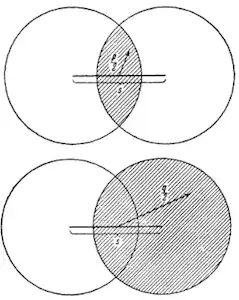How does one obtain the final integral expression in the appendix of Abrikosov and Khalatnikov's 1958 paper: $\ \ \ $ "Concerning a model for a non-ideal fermi gas" $\ \ \ $ ???
Below, in Bold, I will mark the point at which I am stuck.
The paper is freely available from JETP -- http://www.jetp.ac.ru/cgi-bin/dn/e_006_05_0888.pdf
This problem is an important one, as the term "$11-2\log{2}$" appears in many fields of physics, e.g., in Fetter and Walecka "Many Particle Systems", Landau and Lifshitz "Statistical Physics", problems in nuclear physics, problems in neutron star equation of state, density-functional theory, etc. However, the integral is never shown in its details, probably because its original derivation by Huang and Yang (1957) used a very laborious approach, and numerical methods are easier these days. Abrikosov suggests an elegant approach, however, and I would like to understand the details.
The problem requires no particular background in condensed matter physics, as the main result is boiled down to computing an integral, which I quote directly from the paper:
In terms of these variables, $E^{(2)}$ takes on the form $$E^{(2)} = -\dfrac{mU^2}{4\,(2\pi\hbar)^9}\int\!\mathrm{d}^3\vec{\bf s} \int\!\mathrm{d}^3\vec{\bf p} \int\!\mathrm{d}^3\vec{\bf q} \ \dfrac{1}{{\bf p}^2-{\bf q}^2}$$ where the region of integration for the vector $\vec{\bf s}$ is $\ 0 < |\vec{\bf s}| < 2p_o\ $ and the range of values for $\vec{\bf p}$ and $\vec{\bf q}$ is shown in the figure.
If we introduce the variables $x_{\bf q} = \cos{({\bf q},{\bf s})}\ $ and $x_{\bf p} = \cos{({\bf p},{\bf s})}\ $, $\ E^{(2)}$ becomes $$E^{(2)} = -\dfrac{8mU^2\pi^3}{(2\pi\hbar)^9} \int_0^{2p_o}\!\!\!s^2\mathrm{d}s \int_0^1\!\!\! \mathrm{d}x_{\bf p} \int_0^{z(x_{\bf p})}\!\!\!p^2\mathrm{d}p\int_{-1}^1\!\!\!\mathrm{d}x_{\bf q}\int_0^{z(x_{\bf q})}\!\!\!q^2\mathrm{d}q \ \dfrac{1}{p^2-q^2} \ , \ $$ where $z(x)$ satisfies the relation $$z^2+2 z s x+s^2=4p_o^2 \ . \ $$ From this, by means of a series of transformations and partial integrations over $\mathrm{d}x_{\bf p}\ $ and $\mathrm{d}x_{\bf q}\ $ we find $$E^{(2)}=\dfrac{2mU^2p_o^7}{\pi^6\hbar^9}\!\!\!\int_0^1\!\!\!\!\!\!s^2\mathrm{d}s \left[ \int_0^{1+s}\!\!\!\!\!\!\!\!p^2\mathrm{d}p \int_0^{1-s}\!\!\!\!\!\!\!\!q^2\mathrm{d}q + \dfrac{1}{4s^2} \int_{\sqrt{1-s^2}}^{1+s}\!p\mathrm{d}p(1-p^2-s^2) \int_{\sqrt{1-s^2}}^{1-s}\!q\mathrm{d}q(1-q^2-s^2) \right]\frac{1}{p^2-q^2}.$$
Integrating further by parts over ${\bf s}$ and then carrying out the remaining integration, we obtain $$E^{(2)} = (6/35) (3/\pi)^{2/3} (11-2\log{2}) a N^{1/3} E^{(1)} \ .$$
As stated above, I am stuck at the line marked in Bold.
My attempts at a solution have resulted in some muddled results. I am unsure how to make them concrete, but they do check out in mathematica. I will list some of the steps that I have made:
- There is an implicit change of variables $\ s'\to s/2p_o\ $ and the same for $\ z,\ p,\ $ and $q$.
- By means of partial integrations over $\mathrm{d}x_{\bf p}\ $ and $\mathrm{d}x_{\bf q}\ $ , $\ E^{(2)}$ becomes (apart from constants) $$\int_0^{1}\!\!\!\! s^2\mathrm{d}s \left( \int_{0}^{z_1}\!\!\!\!\!\! \mathrm{d}p \int_{0}^{z_{-1}}\!\!\!\!\!\!\!\! \mathrm{d}q \ \ + \int_{0}^{z_1}\!\!\!\!\!\! \mathrm{d}p \int_{z_0}^{z_{-1}}\!\!\!\!\!\!\!\! x(q)\,\mathrm{d}q \ - \int_{z_0}^{z_1}\!\!\!\!\!\! x(p)\,\mathrm{d}p\!\! \int_{0}^{z_{-1}}\!\!\!\!\!\!\! \mathrm{d}q \ - \int_{z_0}^{z_1}\!\!\!\!\!\! x(p)\,\mathrm{d}p\!\! \int_{z_0}^{z_{-1}}\!\!\!\!\!\!\!\! x(q)\,\mathrm{d}q \right) \dfrac{p^2 q^2}{p^2-q^2}$$ where $ \ x(z) = (2sz)^{-1} (1-z^2-s^2) \ $, and $\ z_x\ $ are roots of $\ z^2+2 z s x+s^2=1 \ $ for $\ x=1,\ 0,\ $ etc., namely, $ \ z_0 = \sqrt{1-s^2} \ $ , $ \ z_1 = 1-s \ $ , $ \ z_{-1} = 1+s \ .$
- By means of a set of $u$-substitutions, e.g., $2s u=z_o^2 -p^2$ and similar substitutions, $\ E^{(2)}$ transforms to (apart from constants) $$\int_0^{1}\!\!\!\! s^2\mathrm{d}s \int_{0}^{z_1}\!\!\!\!\!\!\! p\,\mathrm{d}p \int_{0}^{z_{-1}}\!\!\!\!\!\!\! q\,\mathrm{d}q \left( \dfrac{p q}{p^2-q^2} + s\ \dfrac{p}{z_0^2-p^2+2sq} + s\ \dfrac{q}{z_0^2-q^2-2sp} +\dfrac{s}{2} \dfrac{1}{p+q} \right)$$
- Recognize at this point that the middle two terms must equal $\ (-2)\ \times \ $ the final term, then the result in the paper is obtained if one can show that (?) $$\int_0^{1}\!\!\!\! s^3\mathrm{d}s \int_{0}^{z_1}\!\!\!\!\! p\,\mathrm{d}p \int_{0}^{z_{-1}}\!\!\!\!\!\!\! q\,\mathrm{d}q \left( \dfrac{1}{p+q} + \dfrac{p}{z_0^2-p^2+2sq} + \dfrac{q}{z_0^2-q^2-2sp} \right) \ =^{\bf ???} \ 0 \ .$$
- To facilitate a contour integral to show that the integral vanishes, go back to the first step and extend the domain to infinity by a change of variables (familiar from relativistic mechanics) $$ p’ = \dfrac{p}{\sqrt{1 - s^2}} \ \ , \ \ q’ = \dfrac{q}{\sqrt{1 - s^2}} \ \ , \ \ s’ = \dfrac{s}{\sqrt{1 - s^2}} \ \ , \ \ z’ = \dfrac{z}{\sqrt{1 - s^2}} \ \ , $$ which results in a change in the root equations: $$(z’)^2+2 z’ s x-1=0 \ , \ $$ and $ \ z’_0 = 1 \ $ , $ \ z’_1 = \sqrt{1+s^2}-s \ $ , $ \ z’_{-1} = \sqrt{1+s^2}+s \ .$ The problem reduces to show that (?) $$\int_0^{\infty}\!\!\!\! \dfrac{s^3\mathrm{d}s}{(1 + s^2)^{9/2}} \int_{0}^{z’_1}\!\!\!\! p\,\mathrm{d}p \int_{0}^{z'_{-1}}\!\!\!\! q\,\mathrm{d}q \left( \dfrac{1}{p+q} + \dfrac{p}{1-p^2+2sq} + \dfrac{q}{1-q^2-2sp} \right) \ =^{\bf ???} \ 0 \ \ \ ({\bf ???})$$
- Can I perform a contour integral over $s$ to show this is zero? How do I handle the $s$ appearing in the limits? Recalling that the goal was merely to eliminate the integrals with a single factor of "$\ x\ $" in step (2.), have I strayed too far from the path to get here?
- Are there more transformations like this that I have missed?
BOTTOM LINE: How and which "transformations" were used to obtain the final square brackets integral expression in the paper, with just two very symmetric terms?
